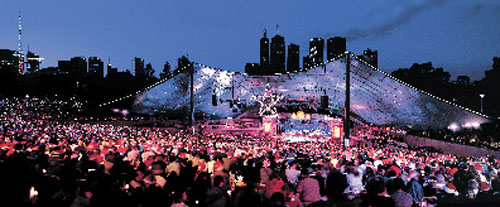Live tunes, with the summer sky as your roof

The Sidney Myer Music Bowl in Melbourne, Australia, hosts a variety of outdoor events. [JoongAng Ilbo]
The best part about outdoor music events is that you can stretch out your legs and lie down on a blanket in the grass, perhaps even enjoy a picnic and sip beer while you soak up some music. The magic really begins when the sun sets and the temperature drops, allowing you to fully relax after a hot summer day.
And no need to worry about rain, as concert organizers often erect huge pavilions to cover not only the stage but also the audience.
Outdoor concerts are all the rage here these days. Koreans are flocking in large numbers to open-air music shows at all types of venues, including palaces, temples, resorts and parks. Some of the biggest this year include the recent Jisan Valley Rock Festival, the ongoing International Great Mountains Music Festival & School, and the Grand Mint Festival slated for October.
While the fad is relatively new here, outdoor concerts have long been a popular summer past time elsewhere. Some of the most popular include the Aspen Music Festival and School in Colorado, the Tanglewood Music Festival in Massachusetts and the Grant Park Music Festival in Chicago.
There are plenty of smaller, lesser-known ones as well, such as the Grafenegg Music Festival, an annual event held at Grafenegg Castle in the outskirts of Vienna, Austria, from late August to early September.
Although a relative newcomer on the scene - it started in 2007 - the festival can serve as an ideal model for Korea’s burgeoning outdoor performances.
Grafenegg Castle, which is a 40-minute drive from Vienna, is a lordly mansion from the 17th century that is surrounded by more than 2,000 coniferous trees and is enveloped by an extensive meadow.
After World War II, the castle was in terrible condition, as it was used as the headquarters of the Soviet Union until 1955. Recent renovations have restored its luster, and it now hosts various events including wine and food tastings that draw swarms of tourists.
The provincial government in this small town, which has a population of just 2,830, invested about 25 million euro (44 billion won, $35.9 million) to develop the area as an internationally renowned culture and tourism spot.
Tassilo Metternich-Sandor, the owner of the castle, is the manager behind Grafenegg Music Festival. Rudolf Buchbinder, an internationally known classical pianist, is the artistic director.
The organizers of the festival invested 5 million euro to build the open-air stage, which they named “Wolkenturm,” which translates to “cloud tower.” The giant pavilion does indeed resemble a cloud, or even Napoleon’s hat. It officially accommodates 1,700 people but, including the lawn area, can fit 2,730.
Organizers float a gigantic balloon 26 meters (85 feet) up in the sky, offering shade for audiences. They also sell lunch items and allow visitors to use tables and chairs upon request.
During the first festival in 2007, the weather soured and visitors had to wear raincoats - prompting organizers to build an auditorium last year as a backup.
By Lee Jang-jik [estyle@joongang.co.kr]










with the Korea JoongAng Daily
To write comments, please log in to one of the accounts.
Standards Board Policy (0/250자)